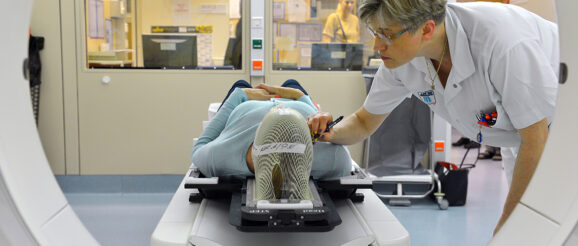Mobilizing for Better Cancer Care through Innovation and Cooperation in Times of COVID-19 | IAEA

Virtually every aspect of healthcare has been affected by the coronavirus pandemic, and cancer care is no exception. Whereas the current crisis requires cancer care professionals to adapt the way they provide services, it also offers opportunities to fast-track innovation and forge new partnerships, panellists agreed at a high-level virtual roundtable on the role of radiotherapy in cancer control at this week’s World Health Summit in Berlin.
“Thanks to recent technological advances, radiotherapy is now more precise and effective than ever before, with fewer side effects and less time needed for delivery,” said IAEA Director General Rafael Mariano Grossi at the event co-convened by the IAEA and Varian Medical Systems, a US-based radiation oncology treatments and software company. Mr Grossi noted that despite these advances, one country in four does not have access to radiotherapy services, and nearly half of the countries in Africa are without a single radiotherapy machine.
Ruiz Gómez, Minister of Health and Social Protection of Colombia, described the cancer burden in Latin America and highlighted that mortality has fallen for various major cancers in Colombia. “This reflects the success of our universal health insurance coverage that offers early cancer detection and treatment to all of our citizens.” With help of the IAEA’s technical cooperation programme, Colombia has also expanded its nuclear medicine and radiotherapy services, but needs remain. “Within the next decade, we expect that numbers of new cancer cases to increase by almost 50 per cent. This is a big challenge, and we need to grow our capacities very rapidly to cope with the disease,” Gómez stated.
The panel, composed of high-level government officials as well stakeholders from the private sector and leading clinical experts, highlighted access to quality cervical cancer treatment as a particular concern. This highly preventable and curable disease kills more than 300,000 women every year, with 90 per cent of them living in low- and middle-income countries. This major inequality has recently led to a historic commitment of the global community. “Just this summer, we saw the adoption of the World Health Organization’s (WHO) global strategy towards the elimination of cervical cancer, with a focus on coverage and equity of access through reaching ambitious targets for scaling up prevention, diagnosis, treatment and palliative care by 2030, which is a huge step forward,” said Julie Torode, Director of Special Projects of the Union for International Cancer Control (UICC).
This WHO strategy includes the aim of providing 90 per cent of women with cervical cancer with quality treatment and care. The IAEA plays a major role in supporting countries to make headway on this agenda. “We can make a difference with increased access to radiotherapy,” Mr Grossi said.
Supriya Chopra, Professor for Radiation Oncology at the Tata Memorial Center in India, added that brachytherapy and internal radiation therapy were the only available cure for women with invasive cervical cancer and that funding their expansion was good investment. “Costs can be recovered in two or three years when looking at the lives of women saved and their contribution to the economy,” she said. Brachytherapy is a type of internal radiotherapy that gives radiation from inside the body – a radioactive source is put close to or inside the tumour to destroy cancer cells, while sparing healthy, surrounding tissue.
